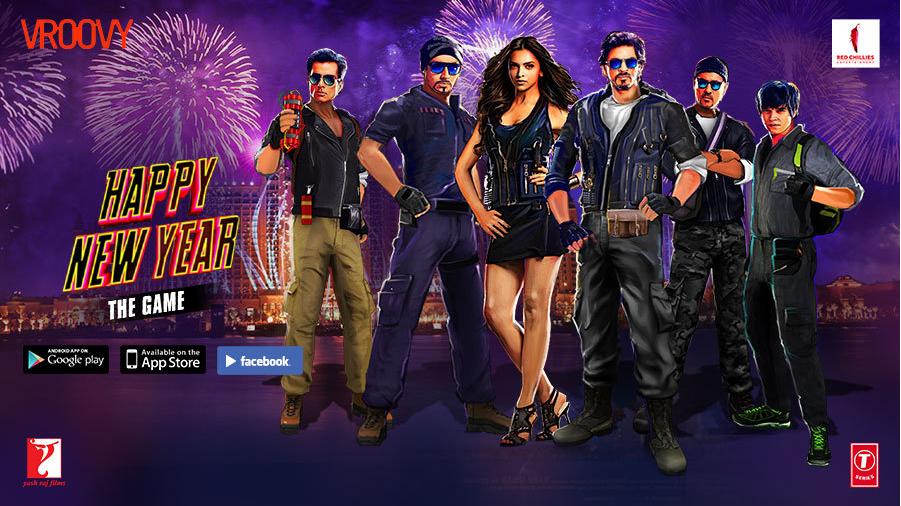 Hungama has been a pioneer in the entertainment industry for the last 15 years and has really grown from strength to strength over the years. In a recent joint venture with Gameshastra, one of India’s established gaming studios, it formed Vroovy, which has produced over 10 games as of now, with ‘Happy New Year – The Game’ being the eleventh venture.
Hungama has been a pioneer in the entertainment industry for the last 15 years and has really grown from strength to strength over the years. In a recent joint venture with Gameshastra, one of India’s established gaming studios, it formed Vroovy, which has produced over 10 games as of now, with ‘Happy New Year – The Game’ being the eleventh venture.
At a recent do in the city, the Happy New Year team along with Hungama MD & CEO Neeraj Roy celebrated the success of the game, which has received over 1.5 million downloads within a week’s time. AnimationXpress.com’s Vivek Kapadia caught up with Neeraj, to get him chatting about Vroovy, the gaming industry in India and what’s in store for the coming years.
Excerpts:-
How did Vroovy come about?
Last three years has seen the advent of smartphones for Indian consumers. Number of internet users has also risen significantly due to the influx of smartphones. This has led to high downloads, with games having a global connect doing exceedingly well. Gameshastra has been doing console gaming like forever and developing games for smartphones is technically a step down, and with Hungama focusing more on casual gaming it was only right to join hands and create a new beast – Vroovy. The idea was to invest in the talent which really understands the smartphone audience’s needs and brings in the multiplayer elements along with it. At Vroovy the focus is on creating independent IPs for a varied audience. People relate Hungama as a brand to digital services, movies, music among other things, thus Vroovy is the answer for the gaming needs of the Indian audience.
Is Vroovy concentrating on movie based games or are you planning independent IPs as well?
 As a company we are looking into five to six genres of games we can come up with. This includes classic action, arcade & sports among others and then we have our tent pole properties that we will keep developing. With movie based games you can bring in more audience to playing those titles be it is urban or rural in nature. The power of entertainment and cinema is the largest and widest in this country. When compared to China where the gaming industry is pegged at around $18 billion; gaming in India is still at a nascent stage. I don’t think we can get there as yet because in India we have lot of distractions for the audience; with around 750 channels on television catering to the audience all over India, our broadcasting market is larger than any other in the world. Even in cinema, we don’t only have the Hindi film industry, but also a dozen regional language markets and each one is doing really well. With games we need to reach out to a wider audience and the movie based games help us do that. Globally, after music and video consumption gaming is the third most consumed category on the smartphone network. By 2018, when there will be more than 600 million users on internet our ultimate goal is to atleast have 300 million of those playing games and there is no reason that this feat can’t be achieved.
As a company we are looking into five to six genres of games we can come up with. This includes classic action, arcade & sports among others and then we have our tent pole properties that we will keep developing. With movie based games you can bring in more audience to playing those titles be it is urban or rural in nature. The power of entertainment and cinema is the largest and widest in this country. When compared to China where the gaming industry is pegged at around $18 billion; gaming in India is still at a nascent stage. I don’t think we can get there as yet because in India we have lot of distractions for the audience; with around 750 channels on television catering to the audience all over India, our broadcasting market is larger than any other in the world. Even in cinema, we don’t only have the Hindi film industry, but also a dozen regional language markets and each one is doing really well. With games we need to reach out to a wider audience and the movie based games help us do that. Globally, after music and video consumption gaming is the third most consumed category on the smartphone network. By 2018, when there will be more than 600 million users on internet our ultimate goal is to atleast have 300 million of those playing games and there is no reason that this feat can’t be achieved.
What is holding back the Indian gaming studios from creating a lot more original content?
This has been a perennial issue for a lot of Indian gaming and software companies, which is a little frustrating to see. The Indian market or the products coming out need to reach 50 million consumers over a period of 6 months and if we achieve such numbers, in a year we could be in that zone where we could create original IPs. We are adding approximately seven million new users a month to the internet world and by March 2016 we should have definitely crossed 300 million in India, so the market out here is huge. With Happy New Year – The Game, we’ve reached over 1.5 million unique users in just six days and that in self is a remarkable achievement. Studios like Rovio took 34 to 36 games to come up with an idea like Angry Birds and look where they are now. The company that created the global phenomenon – Candy Crush Saga – is valued at about $5 billion, with about $1.5 billion in revenues itself. I don’t subscribe to the fact that in three years we’ll do a billion dollar business, but India has its own nuances and we need to value that. We have to adapt ourselves according to the audience and use it to our own advantage.
Console gaming hasn’t really picked up in India, do you attribute it to the pricing issue?
We’ve been working very closing with Microsoft and their idea is to proliferate. Gaming is about $80 to $82 billion business globally of which console takes half the market share. The quality of gameplay on the consoles is enriching and also a relief for players from their mundane lives, giving them an out of body experience and really creating an aura which is larger than life. There is an ongoing innovation with console gaming with advancements like Kinect, the games are getting more and more interactive. Here, we have a very small ecosystem and the publishers are not too aware on how to increase profitable or return on investment with the evil of piracy creeping in. I am banking strongly on the smartphone market to outdo what the console couldn’t achieve in India. We are at the cusp of transition from 2G to 4G, where 10 MB/S internet speed will be a reality in about six months, making a 300 MB file much more feasible for a smartphone without compromising on the quality.

Piracy has forever taken a toll on the entertainment industry, how big an impact does it have on the gaming industry?
We too have been majorly hit by this and have had instances like that in the past. For our game Race 2, we launched it in a paid version on Google Play Store but in just a couple of days it was hacked and we had no alternative but to give out the game for free. India doesn’t boast a juicy advertising market compared to other countries. Just to draw parallels, China has an online advertising market of around $24 billion whereas in India, total advertising market across TV, Print, Outdoor, Radio, Online and Digital is a meager $7 billion. So giving out our games for free requires lot of innovation and bringing in brands to provide the necessary boost. We can’t rely on a Silicon Valley business model and hope that it will create scale.
What is next for Vroovy? Are you encouraging more indie developers?
One of the charters for Vroovy is that we are going to launch our own game platform, where we will have our games and also new games will be releasing every month from other developers as well. And you will be pretty sure that every month new IPs will be coming up on our network. Whether the games are in connection with movies, television shows and events; gaming as a form of engaged entertainment is here to stay. Gaming in India has come a long way and is no longer a fad or experiment, but an evolved form factor.
